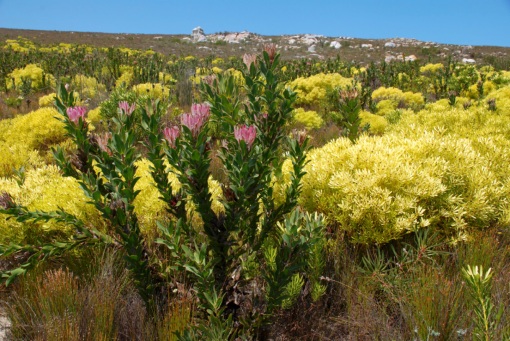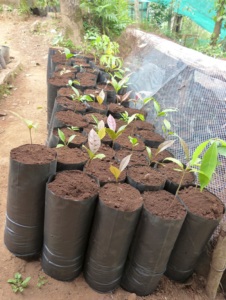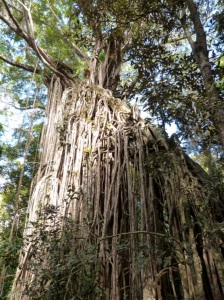
Protea compacta in fynbos, a form of shrubland at Soetanysberg, South Africa. Photo: Brian van Wilgen
Restoration of lost habitats and ecosystems hits all the right notes — conservation optimism, a can-do attitude, and the excitement of seeing biologically impoverished areas teem with life once more.
The Strategic Plan of the Convention on Biological Diversity includes a target to restore at least 15% of degraded ecosystems. This is being enthusiastically taken up in many places, including through initiatives such as the Bonn Challenge, a global aspiration to restore 350 million hectares of deforested and degraded land by 2030. This is in recognition of the importance of healthy ecosystems in not just conserving biodiversity, but also in combating climate change. Peatlands and forests lock away carbon, while grassland diversity stabilises ecosystem productivity during extreme weather events. So how can we make sure that these restoration efforts are as effective as possible?

Tree seedlings that will be used to restore tropical wet forests in the Anamalai Hills, India. Photo: Claire Wordley
There are debates about which habitats should be put back, and where, about the degree to which humans should intervene and manage a site, and about which metrics tell you that a habitat is ‘healthy’. But there is also debate about how well different restoration methods actually work.
To address the latter, the Endangered Landscapes Programme is launching a new online resource, www.restorationevidence.org, to collect the evidence for how restoration attempts have affected habitats and the biodiversity that lives there. A subset of www.conservationevidence.com, this website aims to support restoration ecologists by only showing material relevant to them. For each ‘intervention’ that a restoration ecologist might do, from rewetting peat to simply allowing shrubland to regenerate, scientific studies testing the effectiveness of each intervention are gathered, summarised, and presented in a digestible manner. This allows those planning restoration projects to make a decision about what is right for their site based on the best available evidence.

Ficus tree in a rainforest fragment that is part of a wider landscape reconnection and restoration programme in Queensland, Australia. Photo: Claire Wordley
So far, the site mostly addresses the impacts of restoration interventions on the vegetation of forests, shrublands/heathlands and peatlands, with some evidence on the impacts of restoring habitats for taxa such as amphibians, birds and bats. Work is underway to add the evidence for grasslands, for wetland habitats beyond peat such as reedbeds, rivers, marshes and lakes, and for the impacts of restoration on a wide range of mammals. In time, evidence for even more interventions (such as coral reef restoration, and the impacts of habitat restoration on invertebrates), will join the collection.
For those with an interest in applying evidence to restoration projects, this should be a valuable resource for years to come. The aim is to update each ‘synopsis’ (such as peatlands or forests) every few years to add new evidence, meaning that this project will remain relevant and up to date. Practitioners applying the evidence now can also test what they are doing, publish it, and their results will be integrated into the database in the future. The more we evaluate and learn, the better we can spend restoration funds, and the more effectively we can restore the varied and wonderful ecosystems of this planet.
Claire F. Wordley, Conservation Evidence, University of Cambridge
The Endangered Landscapes Programme is funded by Arcadia, a charitable fund of Lisbet Rausing and Peter Baldwin, and is managed by the Cambridge Conservation Initiative.
More photos available here.



If human population keeps growing, these actions will likely fail more often than endure. But the effort is still worthwhile in my view.
LikeLiked by 1 person
This is a wonderful addition to the readily accessible repository of knowledge which can be utilised in Retention,Restoration and Revegetation works! Increasingly necessary unfortunately!
LikeLiked by 1 person